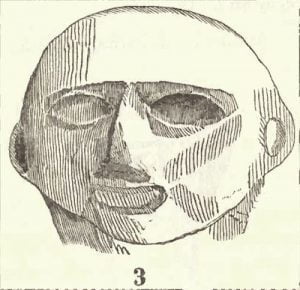
Onondaga was, from the remotest times, the seat of the Iroquois government. Granting credence to the account of their own origin, on the high grounds or falls of the Oswego, they had not proceeded far up the course of the widely gathered waters of this stream, when a portion of them planted their wigwams in this fertile region. Whatever was the cause of their migrating from their primary council fire, nothing was more natural than that, by pursuing this stream upward, they should separate into independent tribes, and by further tracing out its far spread forks, gradually expand themselves, as they were found by the discoverers and first settlers, over the entire area of western New York. On reaching the grand junction of Three River Point, a part went up the Seneca river, who subsequently dividing, formed the Senecas and Cayugas. The bands who took the eastern fork, or Oneida River, pushed forward over the Deowainsta, or Rome summit, into the first large stream, flowing east, and became the Mohawks. The central or Onondaga fork was chosen by the portion who, from the hill country they first located in, took this name; and from them, the Oneidas, pursuing in fact the track of the Mohawks, were an off-shoot. That such was the general route, and causes of their separation, appears as evident as strong probabilities, in coincidence with their own traditions and modern discovery, can make it. That the whole of the original number who started from the south banks of Lake Ontario, did not keep together till they reached the valley of the Hudson and the sea, and then go back to the west, for so their general tradition has it, is also both reasonable and probable to suppose. Large bodies of hunters cannot keep long together. They must separate to procure food, and would separate from other causes. The first effect of their separation and spread into various rich vallies, abounding in game, nuts and fish, was a rapid increase in population. The next, to become overbearing, quarrel about territory, and fight. They were compelled to build forts to defend their stations, or secure their women and children, at night, and by this system, kept down their population to about its first point of increase. It is altogether probable that they did not more than maintain, for ages, a stationary population, which occasionally went down by disease and other calamities, and again revived, as we know that natural causes, in the laws of vitality, will revive a people quickly, after the scourge of pestilence.
The idea of a confederation was, it is believed, an old one with this people, for the very oldest traditions speak of something of this kind, among the lake and St. Lawrence tribes of older days. When the present league was formed, on the banks of the Onondaga lake, this central tribe had manifestly greatly increased in strength, and distinguished itself in arms, and feats of hunting and daring against giants and monsters, for in such rencontres their traditions abound.
Most distinguished, however, above all others, east or west, was a leader of great courage, wisdom and address, called Atotarho; and when they proposed to form a league, this person, who had inspired dread, and kept himself retired, was anxiously sought. He was found, by the Mohawk embassy, who were charged with the matter, sitting as he is represented in the annexed cut, composedly in a swamp, smoking his pipe, and rendered completely invulnerable, by living serpents. These animals extended their hissing heads from all parts of his head and body. Every thing about him, and the place of his residence, was such as to inspire the utmost fear and respect. His dishes and spoons were made of the skulls of enemies, whom he had slain in battle. Him, when they had duly approached with presents and burned tobacco in friendship, in their pipes, by way of frankincense, they placed at the head of their league, as its presiding officer. They collected a large quantity of wampum, and invested him with a broad belt of this sacred article. I found the original drawing of this personage, from which the above is reduced, in the summer of 1845, in the house of a Seneca on the Cattaragus reservation. The owner of this curious pictorial relic, on being asked, proceeded to a chest and carefully took it from its envelope, and allowed me to make a copy. It represents Atotarho, at the moment of his discovery, by the Mohawk delegation.
The right thus awarded to the Onondagas, to furnish a presiding officer for the league, has ever been retained, and is still possessed by that canton. To the Mohawks, at the same time, was awarded the Tekarahogea, or chief war captain an office, however, of the general recognition of which, there is a disagreement amongst interpreters.
A singular tradition may be here added. It is said that the XIIIth Atotarho reigned at Onondaga when America was discovered.
Giving to each Atotarho 1 a rule of fifteen years, and taking Hudson’s voyage as the period the Indians allude to, we should have A. D. 1414, as the era of the present confederacy, in place of 1539, before mentioned on the authority of a general tradition recorded by Pyrlaus. We cannot, however, place much reliance upon Cusick’s chronology.
Citations:

